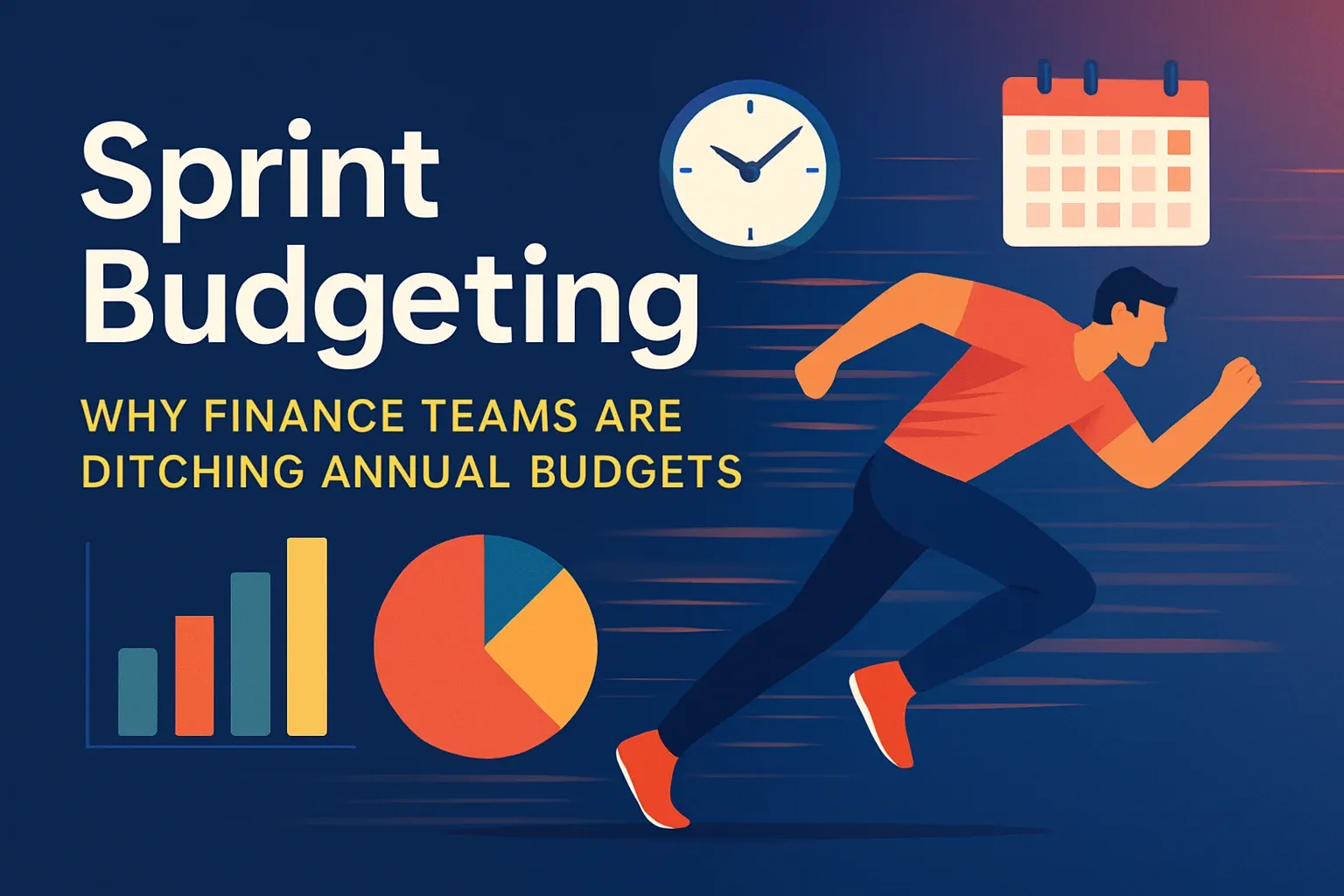What’s Wrong with Annual Budgets
Traditional annual budgets are too slow and rigid for how most businesses operate today. The pace of change—from market demand to supply chain volatility—makes it hard to rely on fixed assumptions set once a year. By the time you’ve built your budget, the numbers may already be out of date.
And yet, many organizations still spend months each year on static budgeting, only to ignore it the moment reality diverges from projections. It’s not just inefficient—it’s wasteful. Finance leaders need a more responsive approach.
What Is Sprint Budgeting?
Sprint budgeting is a short-cycle planning method designed for flexibility. Instead of trying to predict an entire year’s performance upfront, you plan in smaller chunks—typically every two weeks or monthly.
The name borrows from agile software development. Like sprints in agile teams, sprint budgeting lets finance respond quickly, course-correct often, and keep the whole business aligned as new data comes in. You’re not throwing away annual planning—you’re just updating it in real time.
Sprint Budgeting vs. Rolling Forecasts
Rolling forecasts aim for similar agility, but they often remain too high-level. They update revenue and expense projections quarterly or monthly, but lack the structure to drive tactical decisions across departments.
Sprint budgeting goes deeper. It combines regular forecasting with short-term budget cycles, so decisions aren’t just strategic—they’re operational. You’re deciding hiring plans, campaign spends, and inventory purchases on a live basis, not guessing months ahead.
Why Sprint Budgeting Matters Now
Markets change faster than ever. Consumer behavior, supply chain costs, interest rates—nothing stays still. Sticking to static annual budgets leaves businesses exposed or unprepared.
Sprint budgeting is about control. It lets you respond to uncertainty without losing financial discipline. You can pause hiring if sales slow down, or ramp up marketing when new opportunities open up—based on current data, not outdated assumptions.
How Sprint Budgeting Works in Practice
In a typical sprint budgeting setup, finance teams meet every two weeks to review results and adjust forecasts. Department heads come prepared with updated needs or constraints. Together, the group decides what adjustments to make for the next sprint period.
These updates might include:
- Shifting budgets between teams based on new priorities
- Revising revenue forecasts based on pipeline or performance data
- Delaying or greenlighting specific projects
What matters is the rhythm. Teams operate in sync, react to change together, and never go more than a couple weeks without revisiting the plan.
Tools That Enable Sprint Budgeting
Sprint budgeting only works if your systems don’t slow you down. You need:
- Real-time visibility into performance data
- Integrated planning and forecasting tools
- Collaborative workflows that include stakeholders beyond finance
Spreadsheets won’t cut it. They’re error-prone and time-consuming to update. And siloed tools lead to misalignment across teams. Sprint budgeting works best when planning happens in a central system tied to real data.
How NetSuite Enterprise Performance Management (EPM) Improves Sprint Budgeting
NetSuite partners‘ EPM suite is built for fast, collaborative planning. It supports sprint budgeting with real-time syncing across departments, scenario modeling, rolling forecasts, and automated workflows.
You can iterate directly in the system using current data—finance, operations, and sales all working from the same numbers. There’s no need to rebuild forecasts from scratch. Approvals, versioning, and accountability are built in. The result: more agility, less overhead.
Steps to Start Using Sprint Budgeting
Here’s how to begin:
- Assess current planning cycles. Identify how often budgets are reviewed, and where delays happen.
- Define your sprint rhythm. Most companies start with biweekly or monthly cycles.
- Align cross-functional stakeholders. Finance must collaborate with sales, marketing, operations, and HR.
- Choose a system to support collaboration. Cloud-based planning tools with automation help reduce friction.
- Start small and iterate. Pilot with a few departments or business units before expanding.
Benefits of Sprint Budgeting
Teams that adopt sprint budgeting often see benefits like:
- Faster decision-making
- Greater accuracy in forecasts
- Improved cash flow control
- More responsive resource allocation
- Better collaboration across departments
It’s a shift in mindset—from reacting to problems after the fact, to steering proactively based on live data.
Common Challenges (And How to Solve Them)
Challenge 1: Overcomplicating the process. Some teams try to do too much too fast. The fix? Keep the first few sprints simple. Focus on key areas before expanding.
Challenge 2: Lack of engagement outside finance. Sprint budgeting fails without buy-in. Make planning a shared process, not a handoff.
Challenge 3: Poor tooling. Without the right systems, sprints slow down. Invest early in integrated planning platforms, not just spreadsheets.
Final Thoughts on Sprint Budgeting
Sprint budgeting isn’t just a faster way to plan—it’s a smarter way to run your business. When teams operate on short cycles, they don’t just move quickly—they move in sync. Finance becomes a partner, not a gatekeeper. And businesses gain the clarity they need to make the right calls, even in uncertain conditions.
Start where you are. Adjust as you go. Sprint budgeting rewards momentum, not perfection.
Frequently Asked Questions
What is Sprint Budgeting?
Sprint Budgeting is a short-cycle financial planning method where finance teams review, adjust, and reallocate budgets every few weeks—usually every two to four. It replaces long, static annual budgets with quick, responsive updates based on current data.
How is Sprint Budgeting different from traditional annual budgeting?
Annual budgets are fixed and planned months, often becoming outdated. Sprint Budgeting happens more frequently and reflects what’s happening now, not what was predicted six months ago.
How does Sprint Budgeting compare to rolling forecasts?
Rolling forecasts extend your long-term view by constantly updating projections. Sprint Budgeting focuses on short-term, tactical decisions. They work best together: forecasts inform direction, sprints drive immediate action.
What companies should use Sprint Budgeting?
Any business that operates in a fast-changing environment can benefit. It’s especially useful for companies in SaaS, e-commerce, manufacturing, logistics, and marketing-heavy industries.
What are the benefits of Sprint Budgeting?
Teams using Sprint Budgeting often see:
- Faster decision-making
- Better alignment with real-time goals
- Higher forecast accuracy
- Easier collaboration across departments
What tools are best for Sprint Budgeting?
Popular tools include:
- NetSuite Planning and Budgeting
- NetSuite EPM
- Anaplan
- Workday Adaptive Planning
- Planful
- Cube
These platforms support real-time data, collaboration, and flexible scenario modeling.
How does NetSuite EPM support Sprint Budgeting?
NetSuite EPM enables finance teams to plan, forecast, and collaborate in real time. It supports live data access, built-in scenario models, clean version control, and structured workflows—all of which help Sprint Budgeting run efficiently.
Is Sprint Budgeting hard to implement?
It doesn’t have to be. Start small—pick one department, run a few cycles, and refine the process before expanding. The key is setting a repeatable cadence and using the right tools.
Who benefits most from these updates?
Finance teams, inventory managers, executives, and support staff all benefit. The tools reduce manual effort, improve visibility, and make the system easier for everyone to use.







